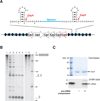Sequence- and structure-specific RNA processing by a CRISPR endonuclease
- PMID: 20829488
- PMCID: PMC3133607
- DOI: 10.1126/science.1192272
Sequence- and structure-specific RNA processing by a CRISPR endonuclease
Abstract
Many bacteria and archaea contain clustered regularly interspaced short palindromic repeats (CRISPRs) that confer resistance to invasive genetic elements. Central to this immune system is the production of CRISPR-derived RNAs (crRNAs) after transcription of the CRISPR locus. Here, we identify the endoribonuclease (Csy4) responsible for CRISPR transcript (pre-crRNA) processing in Pseudomonas aeruginosa. A 1.8 angstrom crystal structure of Csy4 bound to its cognate RNA reveals that Csy4 makes sequence-specific interactions in the major groove of the crRNA repeat stem-loop. Together with electrostatic contacts to the phosphate backbone, these enable Csy4 to bind selectively and cleave pre-crRNAs using phylogenetically conserved serine and histidine residues in the active site. The RNA recognition mechanism identified here explains sequence- and structure-specific processing by a large family of CRISPR-specific endoribonucleases.
Figures



Similar articles
-
Csy4 relies on an unusual catalytic dyad to position and cleave CRISPR RNA.EMBO J. 2012 Jun 13;31(12):2824-32. doi: 10.1038/emboj.2012.107. Epub 2012 Apr 20. EMBO J. 2012. PMID: 22522703 Free PMC article.
-
The CRISPR-associated DNA-cleaving enzyme Cpf1 also processes precursor CRISPR RNA.Nature. 2016 Apr 28;532(7600):517-21. doi: 10.1038/nature17945. Epub 2016 Apr 20. Nature. 2016. PMID: 27096362
-
Mechanism of substrate selection by a highly specific CRISPR endoribonuclease.RNA. 2012 Apr;18(4):661-72. doi: 10.1261/rna.030882.111. Epub 2012 Feb 16. RNA. 2012. PMID: 22345129 Free PMC article.
-
Approaches to study CRISPR RNA biogenesis and the key players involved.Methods. 2020 Feb 1;172:12-26. doi: 10.1016/j.ymeth.2019.07.015. Epub 2019 Jul 17. Methods. 2020. PMID: 31325492 Review.
-
Cutting it close: CRISPR-associated endoribonuclease structure and function.Trends Biochem Sci. 2015 Jan;40(1):58-66. doi: 10.1016/j.tibs.2014.10.007. Epub 2014 Nov 18. Trends Biochem Sci. 2015. PMID: 25468820 Review.
Cited by
-
Altered stoichiometry Escherichia coli Cascade complexes with shortened CRISPR RNA spacers are capable of interference and primed adaptation.Nucleic Acids Res. 2016 Dec 15;44(22):10849-10861. doi: 10.1093/nar/gkw914. Epub 2016 Oct 13. Nucleic Acids Res. 2016. PMID: 27738137 Free PMC article.
-
DNA and RNA interference mechanisms by CRISPR-Cas surveillance complexes.FEMS Microbiol Rev. 2015 May;39(3):442-63. doi: 10.1093/femsre/fuv019. Epub 2015 Apr 30. FEMS Microbiol Rev. 2015. PMID: 25934119 Free PMC article. Review.
-
Genome-directed analysis of prophage excision, host defence systems, and central fermentative metabolism in Clostridium pasteurianum.Sci Rep. 2016 Sep 19;6:26228. doi: 10.1038/srep26228. Sci Rep. 2016. PMID: 27641836 Free PMC article.
-
Exploiting CRISPR/Cas: interference mechanisms and applications.Int J Mol Sci. 2013 Jul 12;14(7):14518-31. doi: 10.3390/ijms140714518. Int J Mol Sci. 2013. PMID: 23857052 Free PMC article. Review.
-
Viral diversity threshold for adaptive immunity in prokaryotes.mBio. 2012 Dec 4;3(6):e00456-12. doi: 10.1128/mBio.00456-12. mBio. 2012. PMID: 23221803 Free PMC article.
References
Publication types
MeSH terms
Substances
Associated data
- Actions
- Actions
- Actions
Grants and funding
LinkOut - more resources
Full Text Sources
Other Literature Sources
Research Materials

